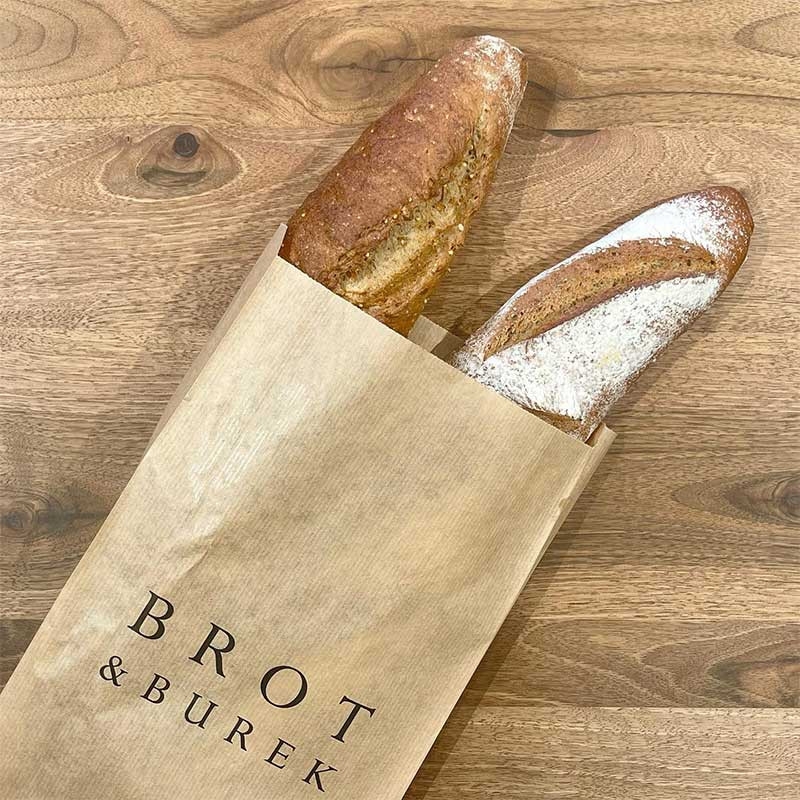Paper bread bags vs. plastic bread bags
By Nikita Nielsen · 21. June 2023
Both paper and plastic bread bags are a common sight in places like bakeries, supermarkets🏪, cafes, and many more.
Paper bread bags are typically used to package freshly baked goods or sandwiches for customers to take away, while plastic bread bags are more commonly used for storing bread to keep it fresh for longer.
In this blog post, we will dive into the uses of paper and plastic bread bags and discuss their practicality, sustainability and printing options.

What are their typical uses?
Custom paper bread bags are often used for takeout orders in bakeries, delis, cafés and many other places. They are perfect for packaging freshly baked goods such as loaves of bread, baguettes and even pastries.
The reason why paper bread bags are usually used for this is that they let air in, ensuring that freshly baked goods stay fresh and crusty and give customers that ‘just baked’ taste.
On the other hand, if freshly baked bread is packed in plastic bags, it can become moist due to the lack of air in the bag.
That’s why plastic bread bags are typically used in supermarkets to pack and seal bread to keep it fresh for a period of time.
What are their environmental impacts?
As sustainability and environmental friendliness become increasingly important to consumers, the choice between paper and plastic bread bags is more relevant than ever.
What are the environmental consequences of paper and plastic bread bags, and is one option more sustainable than the other?
More and more businesses are choosing paper bread bags as an environmentally friendly alternative to plastic bags.
This is because they’re compostable and much more biodegradable than plastic bags, which means they can break down relatively quickly in landfills.
On the other hand, plastic bags can take hundreds of years to decompose. And although plastic bags can be recycled, very few of them are, as many recycling streams do not allow plastic bags for reasons such as them getting stuck in the machines.
Paper bags are much easier to recycle🔄 and are accepted in the recycling streams as long as they are not too contaminated with food.
Nevertheless, the production of paper bread bags requires a lot of water and chemicals that can contribute to environmental problems.
In fact, it takes more resources to produce a paper bag than a plastic bag, and a UK study has found that paper bags need to be reused at least three times to compensate for its environmental impact.
What are their printing options?
Both paper and plastic bread bags offer endless possibilities to highlight your brand with custom printing.
You can print anything from your logo to promotional messages on them, and both types of bread bags come in a variety of colors, textures, and even finishes to choose from.
However, paper bags do have a clear advantage over plastic bags when it comes to printing. Paper bags hold ink very well, making it possible to print much more detailed and vibrant designs on them.
Plastic bags, on the other hand, have a smooth surface which can make it difficult for the ink to stick properly. This can result in a final print that is not as sharp or vibrant.
Apart from printing, paper bread bags have much more to offer in terms of customization options.
For example, they are available in different styles, including baguette bags, and they can even have a window printed on them to show off the delicious baked goods inside.
Conclusion
The choice between paper and plastic bread bags depends on a number of factors such as the intended use, branding opportunities and much more.
Paper bags are used for takeout orders and are preferred by businesses due to their sustainability as well as various customization and printing options, while plastic bags are most often seen in supermarkets where they are used to seal and store bread to keep it soft and fresh for a period of time.
Both paper and plastic bread bags have their own impact on the environment. Although paper bags are more easily recyclable and biodegradable
🌱, their production process still requires a lot of resources.
Plastic bags can take hundreds of years to decompose and their recycling options are limited.
Ultimately, whether you choose paper or plastic bread bags depends on your specific needs and values. Both types of bread bags are excellent packaging options depending on their intended use.

